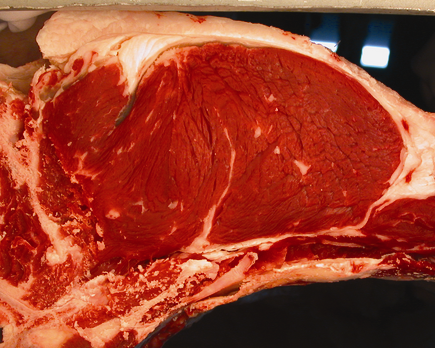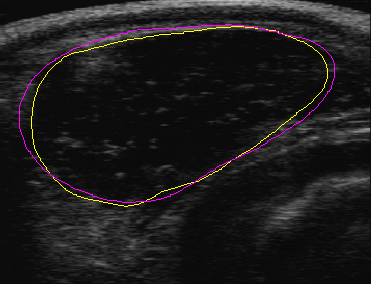
Alimentary Math
 Meat and soybeans are two important food sources in many parts of the world, and in the form of biodiesel fuel, soybeans are a promising source of renewable energy. Two groups of long-term visitors to the IMA during our 2005-2006 program on imaging are contributing to the improved production of these important foodstuffs.
Meat and soybeans are two important food sources in many parts of the world, and in the form of biodiesel fuel, soybeans are a promising source of renewable energy. Two groups of long-term visitors to the IMA during our 2005-2006 program on imaging are contributing to the improved production of these important foodstuffs.
For beef, the rib eye area is an important indicator of the meat quality of an animal. Technology allows ultrasound imaging of cattle on the field, providing a potentially very useful tool for estimating the rib eye area. Deriving accurate estimates from such images is difficult, however, relying on experts who laboriously trace the outline of the rib eye and measure the enclosed area. Moreover, this process cannot be carried out in the field, and is subject to errors due to fatigue, image quality variation, and other factors.
 Gregory Randall, who spent a year at the IMA, and other IMA visitors from Universidad de la Republica in Uruguay have developed a method which enables accurate automatic in-the-field rib eye measurement. Their algorithm processes the ultrasound image data in combination with stored statistical information about rib eye shapes obtained from a bank of curves traced by experts. The method, which has been extensively tested, agrees well with the traditional expert marking and measurement method.
Gregory Randall, who spent a year at the IMA, and other IMA visitors from Universidad de la Republica in Uruguay have developed a method which enables accurate automatic in-the-field rib eye measurement. Their algorithm processes the ultrasound image data in combination with stored statistical information about rib eye shapes obtained from a bank of curves traced by experts. The method, which has been extensively tested, agrees well with the traditional expert marking and measurement method.
Mathematics and imaging science help with the vegetable course as well. Farmers use population estimates obtained by counting the aphids on sample soybean leaves in planning their crop dusting schedules, and so adjust yield and the use of pesticides. As with rib eye tracing, a manual approach to aphid counting is slow, necessarily off-line, and error-prone. However, this low-tech problem presents formidable challenges to even the most sophisticated automatic image segmentation methods. The colors of aphids change as the leaves age, with the color of the aphids on young leaves nearly matching that of leaf veins, and the intricate structure of the veins and the tendency of aphids to cluster near veins further complicate automated image segmentation.
This problem was brought to the IMA’s attention by a USDA researcher, and tackled by Korean mathematician Chang-Ock Lee and his graduate student Jooyoung Hahn during their year stay at the IMA. They started with a segmentation algorithm they had developed which utilizes geometric attraction-driven flow and edge regions, and optimized it for soybean leaf images. The resulting method requires neither interaction with end users nor mid-process parameter manipulations. Within a few weeks, Lee and Hahn were providing highly accurate, efficient aphid counts.

